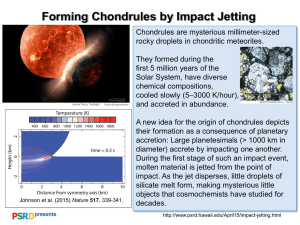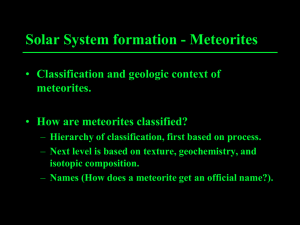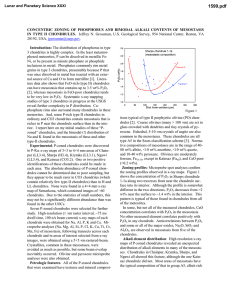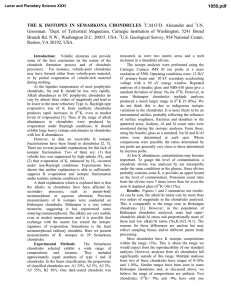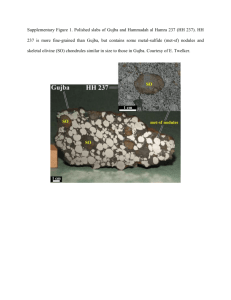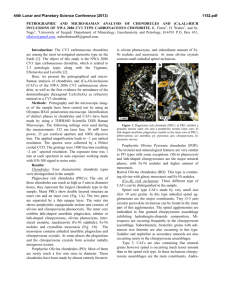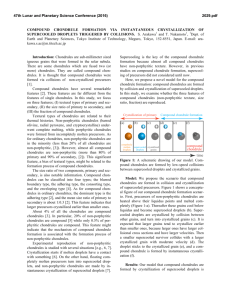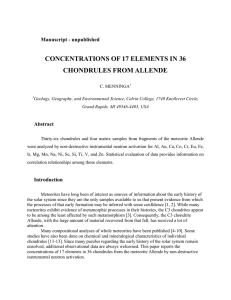THE CHEMISTRY AND STRUCTURE OF THE MATRIX OF SEMARKONA ON... SCALE. Introduction: .
advertisement
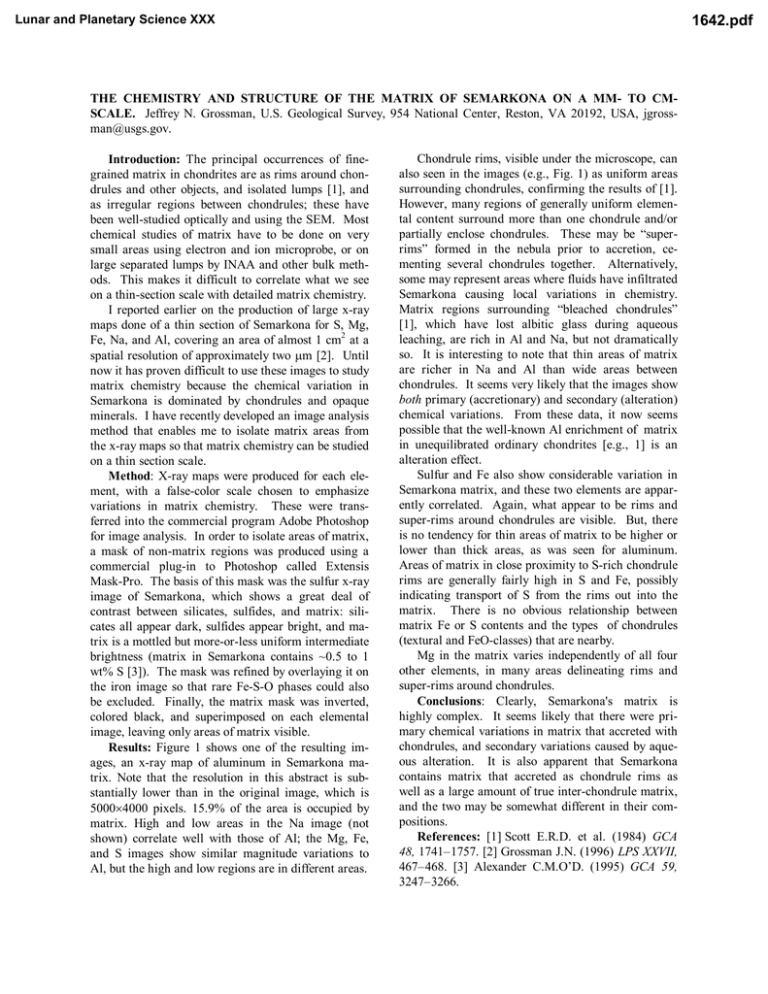
Lunar and Planetary Science XXX 1642.pdf THE CHEMISTRY AND STRUCTURE OF THE MATRIX OF SEMARKONA ON A MM- TO CMSCALE. Jeffrey N. Grossman, U.S. Geological Survey, 954 National Center, Reston, VA 20192, USA, jgrossman@usgs.gov. Introduction: The principal occurrences of finegrained matrix in chondrites are as rims around chondrules and other objects, and isolated lumps [1], and as irregular regions between chondrules; these have been well-studied optically and using the SEM. Most chemical studies of matrix have to be done on very small areas using electron and ion microprobe, or on large separated lumps by INAA and other bulk methods. This makes it difficult to correlate what we see on a thin-section scale with detailed matrix chemistry. I reported earlier on the production of large x-ray maps done of a thin section of Semarkona for S, Mg, Fe, Na, and Al, covering an area of almost 1 cm2 at a spatial resolution of approximately two µm [2]. Until now it has proven difficult to use these images to study matrix chemistry because the chemical variation in Semarkona is dominated by chondrules and opaque minerals. I have recently developed an image analysis method that enables me to isolate matrix areas from the x-ray maps so that matrix chemistry can be studied on a thin section scale. Method: X-ray maps were produced for each element, with a false-color scale chosen to emphasize variations in matrix chemistry. These were transferred into the commercial program Adobe Photoshop for image analysis. In order to isolate areas of matrix, a mask of non-matrix regions was produced using a commercial plug-in to Photoshop called Extensis Mask-Pro. The basis of this mask was the sulfur x-ray image of Semarkona, which shows a great deal of contrast between silicates, sulfides, and matrix: silicates all appear dark, sulfides appear bright, and matrix is a mottled but more-or-less uniform intermediate brightness (matrix in Semarkona contains ~0.5 to 1 wt% S [3]). The mask was refined by overlaying it on the iron image so that rare Fe-S-O phases could also be excluded. Finally, the matrix mask was inverted, colored black, and superimposed on each elemental image, leaving only areas of matrix visible. Results: Figure 1 shows one of the resulting images, an x-ray map of aluminum in Semarkona matrix. Note that the resolution in this abstract is substantially lower than in the original image, which is 5000×4000 pixels. 15.9% of the area is occupied by matrix. High and low areas in the Na image (not shown) correlate well with those of Al; the Mg, Fe, and S images show similar magnitude variations to Al, but the high and low regions are in different areas. Chondrule rims, visible under the microscope, can also seen in the images (e.g., Fig. 1) as uniform areas surrounding chondrules, confirming the results of [1]. However, many regions of generally uniform elemental content surround more than one chondrule and/or partially enclose chondrules. These may be “superrims” formed in the nebula prior to accretion, cementing several chondrules together. Alternatively, some may represent areas where fluids have infiltrated Semarkona causing local variations in chemistry. Matrix regions surrounding “bleached chondrules” [1], which have lost albitic glass during aqueous leaching, are rich in Al and Na, but not dramatically so. It is interesting to note that thin areas of matrix are richer in Na and Al than wide areas between chondrules. It seems very likely that the images show both primary (accretionary) and secondary (alteration) chemical variations. From these data, it now seems possible that the well-known Al enrichment of matrix in unequilibrated ordinary chondrites [e.g., 1] is an alteration effect. Sulfur and Fe also show considerable variation in Semarkona matrix, and these two elements are apparently correlated. Again, what appear to be rims and super-rims around chondrules are visible. But, there is no tendency for thin areas of matrix to be higher or lower than thick areas, as was seen for aluminum. Areas of matrix in close proximity to S-rich chondrule rims are generally fairly high in S and Fe, possibly indicating transport of S from the rims out into the matrix. There is no obvious relationship between matrix Fe or S contents and the types of chondrules (textural and FeO-classes) that are nearby. Mg in the matrix varies independently of all four other elements, in many areas delineating rims and super-rims around chondrules. Conclusions: Clearly, Semarkona's matrix is highly complex. It seems likely that there were primary chemical variations in matrix that accreted with chondrules, and secondary variations caused by aqueous alteration. It is also apparent that Semarkona contains matrix that accreted as chondrule rims as well as a large amount of true inter-chondrule matrix, and the two may be somewhat different in their compositions. References: [1] Scott E.R.D. et al. (1984) GCA 48, 1741–1757. [2] Grossman J.N. (1996) LPS XXVII, 467–468. [3] Alexander C.M.O’D. (1995) GCA 59, 3247–3266. Lunar and Planetary Science XXX 1642.pdf MATRIX IN SEMARKONA: J. N. Grossman Figure 1. Aluminum x-ray map (false color) of Semarkona matrix: Al increases in the sequence dark blue, light blue, green, yellow. All chondrules and coarse-grained metal, sulfide, and oxide minerals have been masked out, and appear as black. The dimensions of the image are 1.0 × 0.8 mm.
